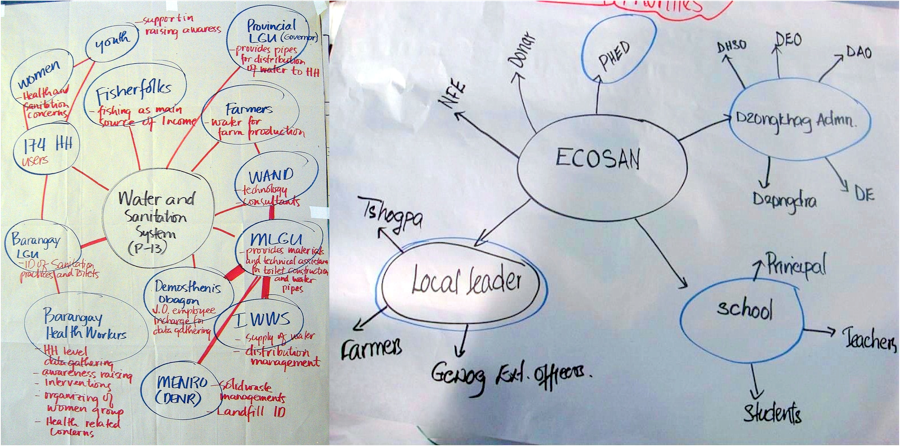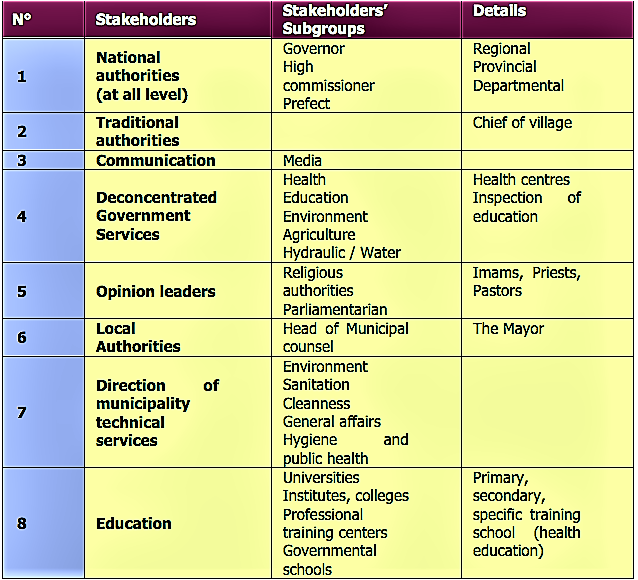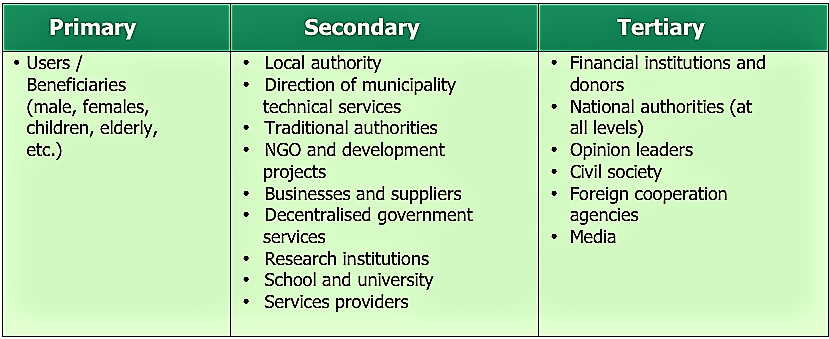Resumen ejecutivo
Participatory planning requires the involvement of concerned stakeholders. This includes identifying public concerns and values and developing a broad consensus on planned initiatives. It is also about utilising the vast amount of information and knowledge that stakeholders hold to find workable, efficient and sustainable solutions (CAP-NET 2008). The stakeholder analysis is the process of identifying and analysing stakeholders, and plan for their participation (RIETBERGEN-McCRACKEN et al. 1998). There are a great number of methodologies concerning stakeholder analysis with a wide range of complexity (see e.g. RIETBERGEN-McCRACKEN et al. 1998; NETSSAF 2008; CAP-NET 2005). Here, we present a four-step methodology, that can be done fully or shortened according to one’s needs: (1) Stakeholder identification, (2) Stakeholders’ importance and influence (3) Stakeholder interests and (4) Stakeholder strategy plan. Learn more about step 1 here:
What Is a Stakeholder?
“Stakeholders are people, groups, or institutions which are likely to be affected by a proposed intervention (either negatively or positively), or those which can affect the outcome of the intervention” (RIETBERGEN-McCRACKEN et al. 1998).
Identification of Key Stakeholders
The first step of a stakeholder analysis is to identify the key stakeholders — i.e., those who are affected by the outcome, negatively or positively, or those who can affect the outcomes of a proposed intervention (NETSSAF 2008) — from the large array of institutions and individuals that could potentially affect or be affected by the proposed intervention (RIETBERGEN-McCRACKEN et al. 1998).
The identification criteria of stakeholders for Sustainable Sanitation and Water Management will have to answer the following questions:
- Who are the people/groups/institutions that are interested in the intended initiative? What is their role(polluter, regulator, direct consumer, indirect consumer, etc.)?
- Who are the potential beneficiaries?
- Who might be adversely impacted? Who has constraints about the initiative?
- Who may impact the initiative? Who has the power to influence?
To start with, stakeholder identification can be done through a brainstorming process to collect an exhaustive list of people/groups/institutions (NETSSAF 2008). The more people and possible stakeholders are involved in the brainstorming, the less likely it will be to miss important stakeholder groups.

In order not to loose the overview, it pays to structure and/or group them in a second step. This can be done by mindmaps, venn diagram, or structured tables as in the examples below.
After structuring/grouping of stakeholders, the following questions might help to reflect the findings and to prevent forgetting important stakeholders:
- Have all stakeholders been listed?
- Have all potential supporters and opponents of the project been identified?
- Has gender aspects been factored in to identify different types of female stakeholders?
- Have the interests of vulnerable groups (especially the poor) been identified?
- Are there any new stakeholders that are likely to emerge as a result of the project? (ODA 1995)
See also venn diagram, brainstorming, mindmaps.
Sometimes it is worth to further group and categorise stakeholders to get a more detailed analysis on the influence and importance.

For structure and documentation reasons this can of value to provide a clear overview about the nature and role of the stakeholder. It also helps one not to forget important stakeholders for planning and implementation and to consider every stakeholder from different levels. However, it depends on your timeframe and your personal preference to do a further categorisation.
Three Categories of Stakeholders

- Primary stakeholders such as direct beneficiaries and direct concerned person (end users, farmers, urban poor, etc.)
- Secondary stakeholders, i.e. intermediaries in the process of delivering aid to primary stakeholders (e.g. professionals, advisers, practitioners, consultants, experts, governmental, NGO and private sector organisations etc.)
- External stakeholders such as decision, policy makers (politicians, senior civil servants, district level bodies, governmental bodies, etc.) (NETSSAF 2008)
Subscribe here to the new Sanitation and Water Entrepreneurship Pact (SWEP) newsletter. SWEP is a network of organizations joining hands to help entrepreneurs design and develop lasting water and sanitation businesses.
Stakeholder Analysis Steps
Continue with analysing -----> Step 2: stakeholders importance and influence
Or see also:
-----> Step 3: stakeholder interests
-----> Step 4: stakeholder strategy plan
The identification of possible stakeholders is a precondition for any participatory planning process. If stakeholders are not identified, they cannot be invited to participate! Furthermore, all parts of a stakeholder analysis should not only be done on the desk by planners and project managers, but should be repeated with representatives of the involved stakeholder groups. This assures a deeper understanding on the issue by the stakeholders and prevents the exclusion of stakeholders at an early stage.
Integrated Water Resources Management Plans. Training Manual and Operational Guide
The Cap-Net manual is an introduction to essential parts of integrated water resource management (IWRM). Chapter 2 consists of management planning for IWRM, which provides good information about stakeholder process as well.
CAP-NET (2005): Integrated Water Resources Management Plans. Training Manual and Operational Guide. Pretoria: Cap-Net URL [Visita: 30.06.2019]Integrated Water Resource Management for River Basin Organisations. Training Manual
Capacity Building for Ecological Sanitation
This publication deals with the educational aspects linked to ecologically sustainable sanitation, and contains extensive chapters on capacity building and knowledge management in the field of ecological sanitation.
UNESCO/IHP ; GTZ (2006): Capacity Building for Ecological Sanitation. Paris & Eschborn: German Agency for Technical Cooperation (GTZ) & International Hydrological Programme of UNESCO (UNESCO/IHP) URL [Visita: 15.04.2019]NETSSAF Participatory Planning-Approach
This is the actual tutorial of the participative planning approach developed by NETSSAF, containing all the steps, sub-steps and case studies. It is freely available on the internet in French and English.
NETSSAF (2008): NETSSAF Participatory Planning-Approach. A tutorial for sustainable sanitation planning. Network for the Development of Sustainable Approaches for Large Scale Implementation of Sanitation in Africa (NETSSAF). [Accessed: 29.03.2010] PDFGuidance Note on how to do Stakeholder Analysis of Aid Projects and Programmes
This guidance note provides a step-by-step manual on how to do a stakeholder analysis. Effective strategies for stakeholder participation must be based on good analysis of individuals, groups, and institutions with an interest in a project.
ODA (1995): Guidance Note on how to do Stakeholder Analysis of Aid Projects and Programmes. London: Overseas Development Department (ODA) URL [Visita: 30.06.2019]Strategy Development for Successful Implementation of Ecological Sanitation Approaches in Sri Lanka using Stakeholder Analysis. Report 3 of 3 from "Evaluation of the Appropriateness of Ecological Sanitation in Relation to the Social, Cultural and Economic
The presented stakeholder analysis provides the necessary information to develop strategies for the successful implementation of ecological sanitation approaches in Sri Lanka.
WINDBERG (2009): Strategy Development for Successful Implementation of Ecological Sanitation Approaches in Sri Lanka using Stakeholder Analysis. Report 3 of 3 from "Evaluation of the Appropriateness of Ecological Sanitation in Relation to the Social, Cultural and Economic. Paris: UNICEF URL [Visita: 18.08.2010]Carrying Out a Stakeholder Analysis
Participation and Social Assessment: Tools and Techniques
This resource kit aims to share information and experiences on participatory methods in the context of development cooperation. The primary focus concentrates on providing practical guidance and case examples.
RIETBERGEN-McCRACKEN, J. NARAYAN, D. WORLD BANK (1998): Participation and Social Assessment: Tools and Techniques. Washington: World Bank URL [Visita: 10.05.2010]Integrated Water Resources Management Plans. Training Manual and Operational Guide
The Cap-Net manual is an introduction to essential parts of integrated water resource management (IWRM). Chapter 2 consists of management planning for IWRM, which provides good information about stakeholder process as well.
CAP-NET (2005): Integrated Water Resources Management Plans. Training Manual and Operational Guide. Pretoria: Cap-Net URL [Visita: 30.06.2019]Capacity Building for Ecological Sanitation
This publication deals with the educational aspects linked to ecologically sustainable sanitation, and contains extensive chapters on capacity building and knowledge management in the field of ecological sanitation.
UNESCO/IHP ; GTZ (2006): Capacity Building for Ecological Sanitation. Paris & Eschborn: German Agency for Technical Cooperation (GTZ) & International Hydrological Programme of UNESCO (UNESCO/IHP) URL [Visita: 15.04.2019]Good Practices in Participatory Mapping
This report explores the power of participatory mapping. Covering a range of techniques, intermediaries, tools and impacts, it is shown how a systematic approach could contribute to addressing conflict-related issues and improving community ownership in sustainable environmental and natural resource management.
IFAD (2009): Good Practices in Participatory Mapping. Rome: International Fund for Agricultural Development (IFAD) URL [Visita: 04.05.2010]NETSSAF Participatory Planning-Approach
This is the actual tutorial of the participative planning approach developed by NETSSAF, containing all the steps, sub-steps and case studies. It is freely available on the internet in French and English.
NETSSAF (2008): NETSSAF Participatory Planning-Approach. A tutorial for sustainable sanitation planning. Network for the Development of Sustainable Approaches for Large Scale Implementation of Sanitation in Africa (NETSSAF). [Accessed: 29.03.2010] PDFGuidance Note on how to do Stakeholder Analysis of Aid Projects and Programmes
This guidance note provides a step-by-step manual on how to do a stakeholder analysis. Effective strategies for stakeholder participation must be based on good analysis of individuals, groups, and institutions with an interest in a project.
ODA (1995): Guidance Note on how to do Stakeholder Analysis of Aid Projects and Programmes. London: Overseas Development Department (ODA) URL [Visita: 30.06.2019]Participation and Social Assessment: Tools and Techniques
This resource kit aims to share information and experiences on participatory methods in the context of development cooperation. The primary focus concentrates on providing practical guidance and case examples.
RIETBERGEN-McCRACKEN, J. NARAYAN, D. WORLD BANK (1998): Participation and Social Assessment: Tools and Techniques. Washington: World Bank URL [Visita: 10.05.2010]Getting communities engaged in water and sanitation projects: participatory design and consumer feedback
Community engagement in water and sanitation service delivery is key for ensuring project sustainability and accountability. This Topic Brief looks at community engagement approaches used by WSUP in three cities within the African Cities for the Future (ACF) programme: Antananarivo (Madagascar), Kumasi (Ghana) and Maputo (Mozambique). The Topic Brief highlights some of the key challenges, and ends with practical recommendations for programme managers about how to engage low-income communities in the design of water supply and sanitation projects.
WSUP (2013): Getting communities engaged in water and sanitation projects: participatory design and consumer feedback. London: Water & Sanitation for the Urban Poor (WSUP) URL [Visita: 30.06.2019]Strategy Development for Successful Implementation of Ecological Sanitation Approaches in Sri Lanka using Stakeholder Analysis. Report 3 of 3 from "Evaluation of the Appropriateness of Ecological Sanitation in Relation to the Social, Cultural and Economic
The presented stakeholder analysis provides the necessary information to develop strategies for the successful implementation of ecological sanitation approaches in Sri Lanka.
WINDBERG (2009): Strategy Development for Successful Implementation of Ecological Sanitation Approaches in Sri Lanka using Stakeholder Analysis. Report 3 of 3 from "Evaluation of the Appropriateness of Ecological Sanitation in Relation to the Social, Cultural and Economic. Paris: UNICEF URL [Visita: 18.08.2010]Stakeholder Analysis
This short PowerPoint presentation explains in a brief way how to do a stakeholder analysis and also contains empty tables that can be directly used for analysing stakeholders.
PUBLIC SECTOR IMPROVEMENT FACILITY (n.y): Stakeholder Analysis. URL [Visita: 30.06.2019]Carrying out a stakeholder analysis
This is a very practical, concise and easy to understand set of online guidelines for planning and running training courses. Although the training approaches and techniques described here are based soundly on the sciences of pedagogy and education, they also reflect the practical side of field work in the developing world.
